National Gardening Week: October 9-15, 2022, dig in & celebrate! - local events, gardening clubs + Community Gardens + Bushcare Groups + ideas to celebrate national gardening week
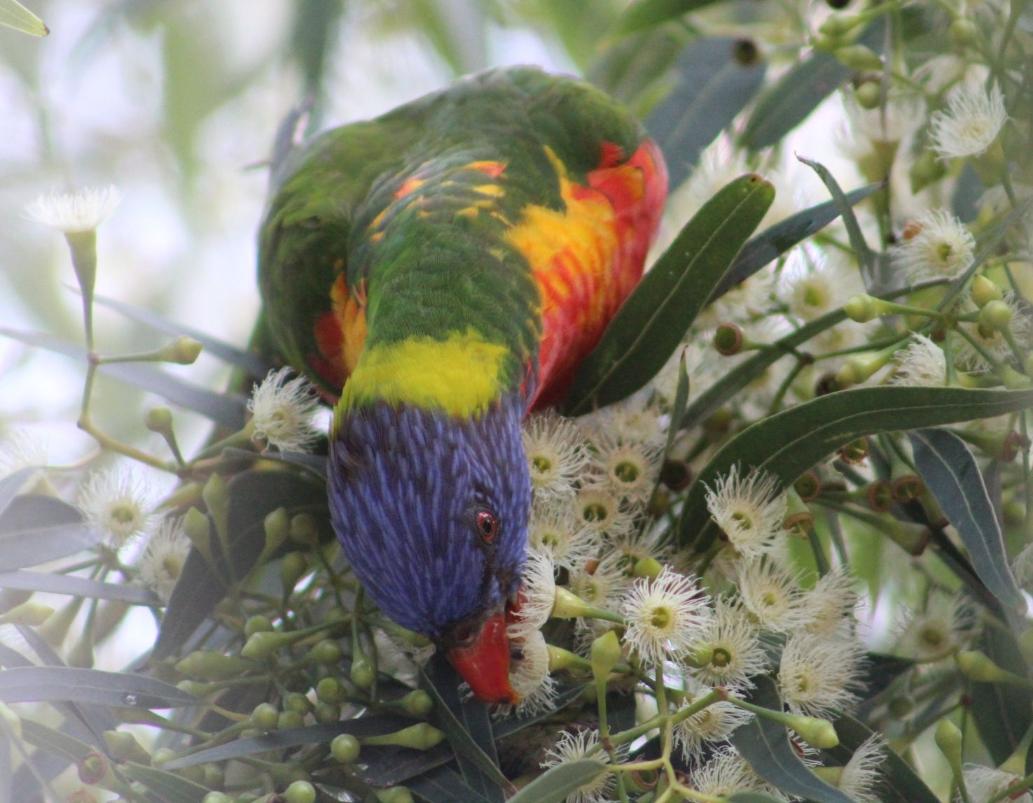
National Gardening Week offers a wonderful opportunity to celebrate the simple joys of gardening and to promote an activity that is good for both mind and body!
Over the last few years, we as a nation have faced droughts, fires, floods and the uncertainty that a global pandemic can bring to our lives. Gardening, whether it be on country acres, a suburban block or a high-rise balcony, can be a refuge from your day-to-day worries, a haven to lose one’s self and a pastime to find peace with nature.
The focus for National Gardening Week 2022 is all about that journey of discovery. Discover the garden, discover the plants and discover the passion! Dig in and discover the simple joys that gardening brings!
In 2022, we also celebrate Queen Elizabeth II’s Platinum Jubilee and to mark the occasion, the Queens Green Canopy initiative or “treebilee”, was launched. The aim is to plant trees to extend the ‘green canopy’ in the UK and across the world. Given our recent devasting bushfires and the loss of so much of our own green canopy, “treebilee” presents a great opportunity to plant a tree and celebrate National Gardening Week.
National Gardening Week is proudly supported by the Garden Clubs of Australia (GCA). Established in 1950, GCA it is the nation’s premiere organisation for garden clubs and other like-minded groups and today has more than 750 affiliates representing over 50,000 members. National Gardening Week fulfils one of the organisations main aims of extending the culture of gardening into the wider community for the benefit of all citizens, with many of the affiliate garden clubs celebrating the event each year.
The driving force behind National Gardening Week is passionate gardener, immediate past president of the GCA and National Gardening Week Ambassador, George Hoad AM. “This year marks the 6th year National Gardening Week will be celebrated across the country and it’d heartening to see so many ‘new’ gardeners coming onboard each year – digging in and celebrating this most enjoyable of activities.”
National Gardening Week is open to everybody – people of all ages, organisations, businesses, local communities, local councils, schools, etc. – to participate in and celebrate gardening in any way they choose. Throw a garden party, visit a local park, join a garden club, plant a tree, visit your local nursery or just spend a day relaxing on the lawn – the list of possible activities is endless!
As in previous years, why not share your planned event with others – on social media, websites or with your local media outlet to share your enthusiasm for gardening with the hashtag #digin&celebrate. Document your event with a photograph or video and upload your celebration to your social media outlets and the National Gardening Week Facebook page with the hashtag #digin&celebrate. Let’s put the nation’s attention on gardening for this one week of the year by digging in.
Local Events on this Gardening Week
Stony Range Regional Botanical Garden, Dee Why Spring Festival
When: Sunday October 30th 2022, 9:00 AM - 3:00 PM
Where: Stony Range Regional Botanic Garden, 810 Pittwater Rd, Dee Why
The 2022 Stony Range Spring Festival celebration was to take place this year on Sunday 9th October in conjunction with the Northern Beaches Group of the Australian Plants Society. This will be a special celebration of the 61st year of this beautiful garden's opening.
We now have a new date for our postponed Spring Festival - Sunday 30th October 9am - 3pm with hope for a better weather forecast.
There will be plant sales and advice, music, live native animals, displays, children's activities, photographs, sausage sizzle and coffee shop. Hoping to see you there.
There will be native plants for sale plus many displays, music on the stage, live native animals, children's fun activities, a BBQ and coffee shop. Also enjoy a guided walk along accessible bush paths, past the garden's cascades, rainforest and striking Hawkesbury sandstone outcrops.
Some History of the 110 years of this place in: Stony Range Regional Botanical Garden: Some History On How A Reserve Became An Australian Plant Park
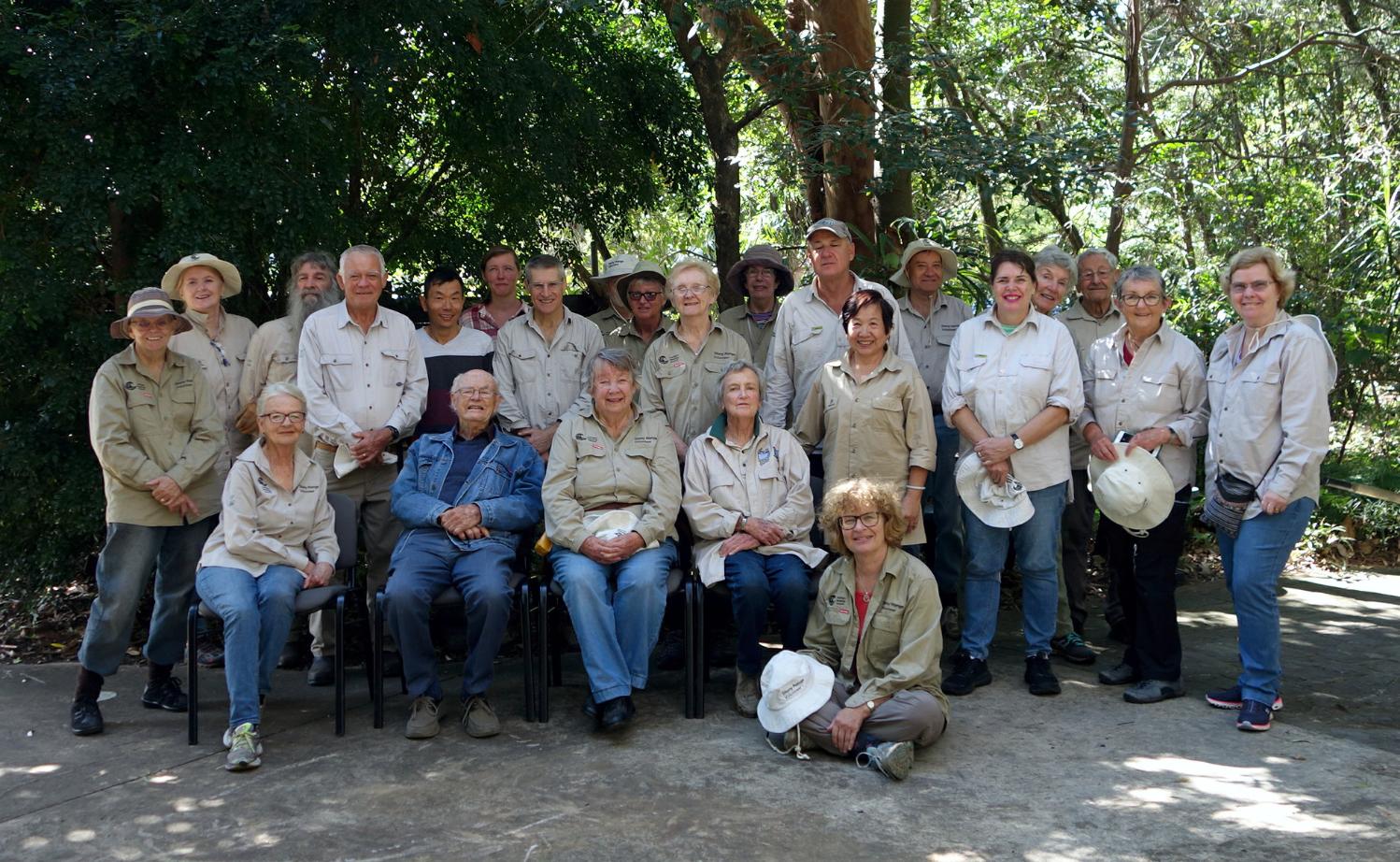
Scotland Island Spring Garden Festival
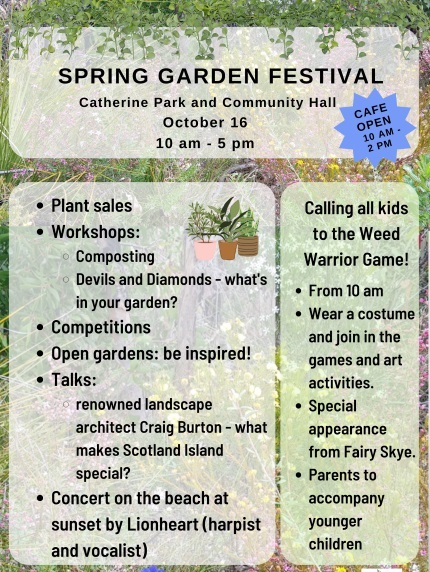
Local Gardening Clubs - community Gardens
Avalon Community Garden Assoc. Inc 2nd Monday 7.30pm More at: www.facebook.com/avcomgarden Ph: 02 9973 1037 - Profile
Balgowlah Community Garden Inc 4th Saturday 10am Ph: 0419 120 124
Fairlight Garden Club Inc 2nd Wednesday 10am or earlier on day trips. Ph: 02 9905 2547
French’s Forest Garden Club Inc 2nd Tuesday 10am Ph: 0409 709 585
Friends Ivanhoe Park Botanic Garden 3rd Monday 7pm – 8.30pm Working Bees 2nd Sat 9.00am – 11.00am Ph: 02 9948 2931
Harbord Diggers Garden Club Last Sunday each month Ph: 0412 427 048
Ku-Ring-Gai Horticultural Society Inc 1st Tuesday 7.30pm (except January) Ph: 02 9449 6245
Ku-Ring-Gai Orchid Society Inc 3rd Monday 8pm (Dec often 2nd Monday) Ph: 0438 877 689
Manly Vale Community Garden Inc Last Saturday monthly PM Ph: 0403 986 400
Manly Warringah Orchid Society Inc 4th Thursday 8pm Ph: 02 9940 0797
Mona Vale Garden Club welcomes members and visitors on the fourth Saturday of the month February to November 9.30am to 12 noon. Meeting at Newport Community Centre, The Boulevarde, Newport.
President Margaret Makin E; fandm.makin@bigpond.com Phone: 9999 2233. Secretary Cheryl Wunsch E; cherylwunsch@optusnet.com.au Phone: 9971 7875
Mosman Garden Club Inc. 2nd Tuesday 6.30pm (Excluding January & July) Email
Narrabeen Lake Garden Club Inc 2nd Friday 10am Ph: 02 9999 2233
Newport Community Garden - We meet every Saturday from 10am till about midday at Woolcott Reserve, Newport. If you would like to join us please direct message us or email us to newportcommunitygardenau@gmail.com Everyone is welcome!!! www.facebook.com/newportcgnsw Profile
Permaculture Northern Beaches 2nd Monday monthly 7-00pm Ph: 04909 349 206 www.facebook.com/permaculturenb Profile
Pittwater Community Garden Association Inc 2nd Tuesday 7.30pm Ph: 0408 983 020
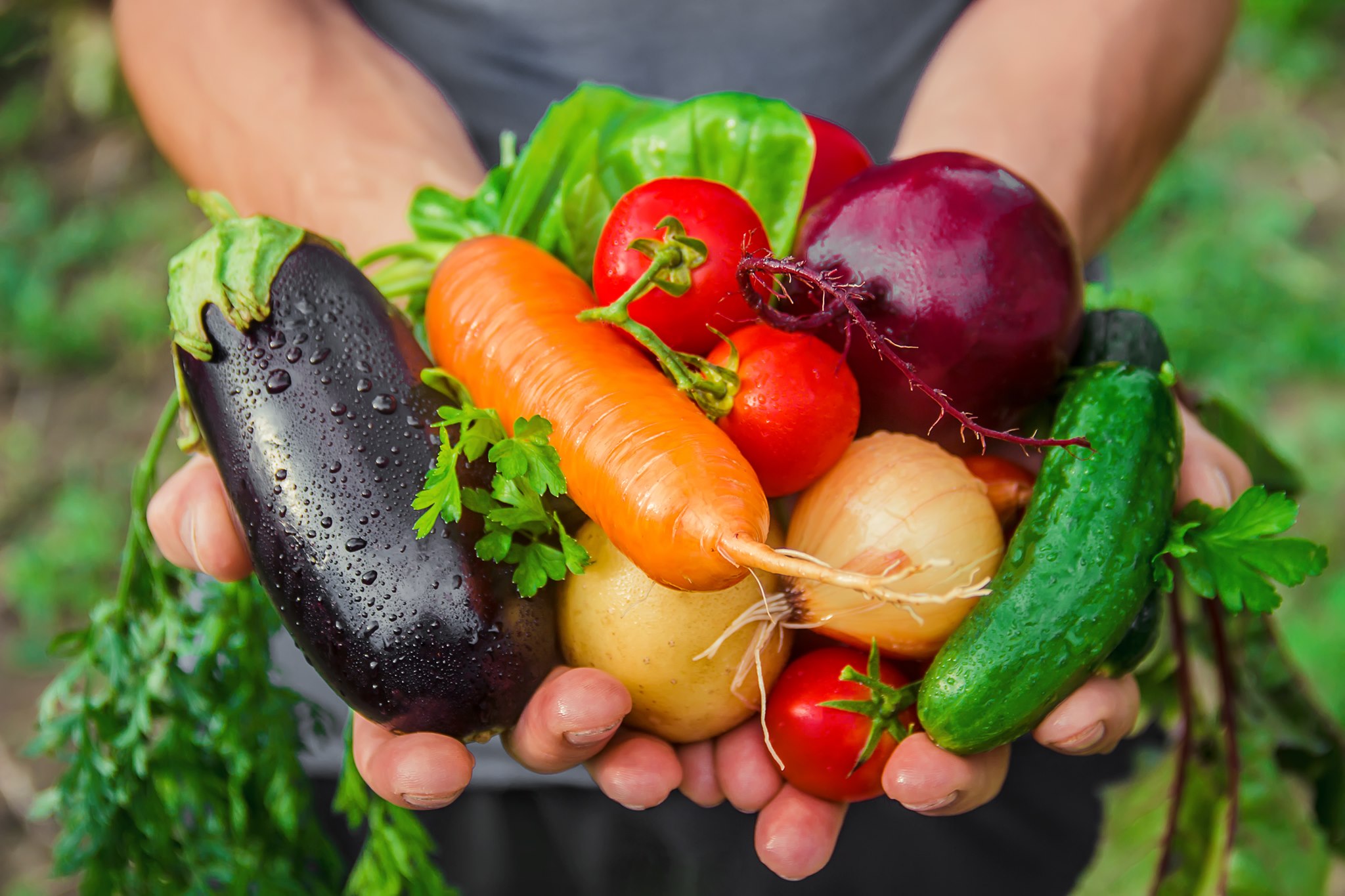
Bushcare In Pittwater
Where we work Which day What time
Avalon
Angophora Reserve 3rd Sunday 8:30 - 11:30am
Avalon Dunes 1st Sunday 8:30 - 11:30am
Avalon Golf Course 2nd Wednesday 3 - 5:30pm
Careel Creek 4th Saturday 8:30 - 11:30am
Toongari Reserve 3rd Saturday 9 - 12noon (8 - 11am in summer)
Bangalley Headland 2nd Sunday 9 to 12noon
Bayview
Winnererremy Bay 4th Sunday 9 to 12noon
Bilgola
North Bilgola Beach 3rd Monday 9 - 12noon
Algona Reserve 1st Saturday 9 - 12noon
Plateau Park 1st Friday 8:30 - 11:30am
Church Point
Browns Bay Reserve 1st Tuesday 9 - 12noon
McCarrs Creek Reserve Contact Bushcare Officer To be confirmed
Clareville
Old Wharf Reserve 3rd Saturday 8 - 11am
Elanora
Kundibah Reserve 4th Sunday 8:30 - 11:30am
Mona Vale
Mona Vale Beach Basin 1st Saturday 8 - 11am
Mona Vale Dunes 2nd Saturday +3rd Thursday 8:30 - 11:30am
Newport
Bungan Beach 4th Sunday 9 - 12noon
Crescent Reserve 3rd Sunday 9 - 12noon
North Newport Beach 4th Saturday 8:30 - 11:30am
Porter Reserve 2nd Saturday 8 - 11am
North Narrabeen
Irrawong Reserve 2nd Saturday 2 - 5pm
Palm Beach
North Palm Beach Dunes 3rd Saturday 9 - 12noon
Scotland Island
Catherine Park 2nd Sunday 10 - 12:30pm
Elizabeth Park 1st Saturday 9 - 12noon
Pathilda Reserve 3rd Saturday 9 - 12noon
Warriewood
Warriewood Wetlands 1st Sunday 8:30 - 11:30am
Whale Beach
Norma Park 1st Friday 9 - 12noon
Western Foreshores
Coopers Point, Elvina Bay 2nd Sunday 10 - 1pm
Rocky Point, Elvina Bay 1st Monday 9 - 12noon
Gardens, Environment Groups, Organisations from Pittwater to Manly
Ideas to Celebrate National Gardening Week
Here’s a few ideas and activities that to celebrate National Gardening Week:
Join your Local Bushcare Group
By joining your local bushcare group you will not only learn more about our area and how we regenerate and restore bush reserves and parks for wildlife and people, you will also make contact with like-minded people, AND get to see the results of your work grow, literally! Full list of local bushcare groups runs below.
Visit your local garden club
Look up your local club and go along to a meeting. Garden clubs are always looking for new members and offer everything from guest speakers, trading tables of interesting plants, floral displays, day outings and overnight trips – all with a cup of tea and yummy treats.
Herbs in the garden or planted in pots
Herbs are easy to grow and useful in the kitchen – plant up a sunny spot in the garden or gather a collection of pots and enjoy the flavours!
Recycle/upcycle quirky containers
Old paint tins, tool boxes, gum boots, shoes make great herb pots or succulent displays.
Create unusual signage in the garden or veggie patch
Use some old bricks, pavers, roofing tiles, rocks and waterproof permanent marker or paint to make unique markers for your veggie or herb patch.
Make a scarecrow
Lots of fun for a classroom activity or rainy afternoon with the kids and a decorative feature in the garden!
Put in a Birdbath
Birds love a drink and somewhere to splash about especially in our hot and dry summers. Buy a birdbath or let your imagination go wild and create your own.
Flower garlands
Creating flower garlands is a fun activity for the classroom, garden club or group of friends and how pretty you’ll look over a cup of tea afterwards.
Community Gardens
If you don’t have the space to garden at home, get involved in your local community garden. You’ll get a whole network of friends to advise and assist you in what you want to grow - and then there will be a harvest!
Games and garden quizzes
A fun way to enjoy the garden and educate at the same time, whether in the shade of a tree or indoors on inclement days.
Create a sensory garden
Create a sensory garden at home, at school, in a nursing home, your local park – anywhere that will enhance the beauty of the place and excite the senses. When planning a sensory garden, it is important to combine plants and elements that appeal to all five senses – sight, sound, smell, taste and touch.
Plant a tree
Plant a tree in your garden, local park, school yard or bush regeneration project – the benefits are amazing! Not only from the pleasure of watching a tree grow and mature, admiring its natural beauty but the fact that it purifies the air by absorbing C02 and other harmful pollutants and releases life giving oxygen. Trees give shade, cool our environment, provide shelter for our wildlife, prevent soil erosion and some give us delicious fruit such as apples and oranges.
Build a bee hotel
Most native bees are solitary and make their nests in a variety of places such as soils, hollows in trees, decaying wood, hollow stems – building a bee hotel is the perfect way to encourage them into your garden, your school yard, etc.
Build a compost heap
Recycle all your vegetable and fruit scraps and create a wonderful soil conditioner and plant food.
Plant up a veggie patch
If your garden or school doesn’t already have a vegetable patch, why not create one!
Flower gardens
Whether in a pot or beds in the garden, the fragrance and colour display that flowers bring to a space is magical.
Also available - the Johnson Brothers DIY Ideas articles - more in their DIY page:
- Johnson Brothers Mitre 10 New Mona Vale Store: The Greenlife Garden Centre
- Go Outside And Play: Creating Garden Spaces To Connect Children With Nature
- Reducing Ticks in Your Garden: Garden care, Plants that Repel, What to Wear Outdoors
- Attracting Insectivore Birds to Your Garden: DIY Natural Tick Control
- Mother's Day 2018: DIY Rose Garden
- Early Spring Garden Care
- Salad Garden For Children
- Keeping Your Garden and Home Cool in Hot Weather
- Classic Beach Garden and Camping Chairs 3 Portable Versions Anyone Can Make
- DIY Outdoor Furniture Mark I: Park Benches for Your Garden
- Summer Garden Jobs: Pruning A Hedge
- How to Make A Swing Chair - With A Frame for Garden Setting
- DIY Garden Shed: Part 1 of 4 - Base
- DIY Garden Shed: Part 2 - Framing Walls
- DIY Garden Shed: Part 2b - Gable Roof Framing
- Garden Shed Part 3: Roof Installation
- DIY Garden Shed: Weather- boards - Door And Window Installation and Paint Finish
- Spring Gardening: Feeding Your Soil And Plants - What Works For Each Plant
- DIY Sandstone Flagging Parking Area - Platform
- DIY Pre-Summer Checklist For A Safe Home
- Summer Spruce Up: Interior Paint Tips and Three easy steps to rejuvenate your timber deck
- The Perfect BBQ Garden Setting
- DIY Water Wise Garden
- DIY Side Gates
- DIY Storm Preparation And Home Protection
- One To Two Day DIY Weekend Spruce Ups
- DIY Child's Waggon - or use as a large planter mover
- DIY Bathroom Refresh: Zing For Spring
- Tips for Growing a Native Garden
- School Holidays DIY Ideas for Children: Little Vegetables Garden, Swing, Windchimes
- Preparing Al Fresco Areas for Christmas Get-Togethers and Summer Visitors
- Summer De-bug; Mosquitoes, flies, cockroaches and ants - how to keep the outdoors insects where they belong
- DIY Summer Projects: Install A Fountain Or Water Feature
- Late Summer and Early Autumn Projects: A Shed For All Storage Solutions + Garden Tasks + Keeping Our Waterways Clean
- DIY Backyard Doggie Paradise
- Garden Care for Heavy Rain Days + Non-Toxic Snail and Slug Debug Ideas
- Garden Design and Plant Management to Minimise Tick Attacks and Infestations - insights from an essay by Bill Conroy BSc. (Agr) (Syd) + a Tribute to Wilfred Lawrence Conroy CBE by Keith Jackson, PNG and others
- Make Your Own BBQ Kitchen Garden: Gifts That Grow Past That Giving Day
Pittwater Reserves: Histories + Notes + Pictorial Walks
A History Of The Campaign For Preservation Of The Warriewood Escarpment by David Palmer OAM and Angus Gordon OAM
America Bay Track Walk - photos by Joe Mills
An Aquatic June: North Narrabeen - Turimetta - Collaroy photos by Joe Mills
Angophora Reserve Angophora Reserve Flowers Grand Old Tree Of Angophora Reserve Falls Back To The Earth - History page
Annie Wyatt Reserve - A Pictorial
Avalon's Village Green: Avalon Park Becomes Dunbar Park - Some History + Toongari Reserve and Catalpa Reserve
Bairne Walking Track Ku-Ring-Gai Chase NP by Kevin Murray
Bangalley Headland Bangalley Mid Winter
Banksias of Pittwater
Barrenjoey Boathouse In Governor Phillip Park Part Of Our Community For 75 Years: Photos From The Collection Of Russell Walton, Son Of Victor Walton
Barrenjoey Headland: Spring flowers
Barrenjoey Headland after fire
Bayview Baths
Bayview Wetlands
Beeby Park
Bilgola Beach
Botham Beach by Barbara Davies
Bungan Beach Bush Care
Careel Bay Saltmarsh plants
Careel Bay Birds
Careel Bay Clean Up day
Careel Bay Playing Fields History and Current
Careel Creek
Careel Creek - If you rebuild it they will come
Centre trail in Ku-ring-gai Chase National Park
Chiltern Track- Ingleside by Marita Macrae
Clareville Beach
Clareville/Long Beach Reserve + some History
Coastal Stability Series: Cabbage Tree Bay To Barrenjoey To Observation Point by John Illingsworth, Pittwater Pathways, and Dr. Peter Mitchell OAM
Cowan Track by Kevin Murray
Curl Curl To Freshwater Walk: October 2021 by Kevin Murray and Joe Mills
Currawong and Palm Beach Views - Winter 2018
Currawong-Mackerel-The Basin A Stroll In Early November 2021 - photos by Selena Griffith
Currawong State Park Currawong Beach + Currawong Creek
Deep Creek To Warriewood Walk photos by Joe Mills
Drone Gives A New View On Coastal Stability; Bungan: Bungan Headland To Newport Beach + Bilgola: North Newport Beach To Avalon + Bangalley: Avalon Headland To Palm Beach
Duck Holes: McCarrs Creek by Joe Mills
Dunbar Park - Some History + Toongari Reserve and Catalpa Reserve
Dundundra Falls Reserve: August 2020 photos by Selena Griffith - Listed in 1935
Elsie Track, Scotland Island
Elvina Track in Late Winter 2019 by Penny Gleen
Elvina Bay Walking Track: Spring 2020 photos by Joe Mills
Elvina Bay-Lovett Bay Loop Spring 2020 by Kevin Murray and Joe Mills
Fern Creek - Ingleside Escarpment To Warriewood Walk + Some History photos by Joe Mills
Iluka Park, Woorak Park, Pittwater Park, Sand Point Reserve, Snapperman Beach Reserve - Palm Beach: Some History
Ingleside
Ingleside Wildflowers August 2013
Irrawong - Ingleside Escarpment Trail Walk Spring 2020 photos by Joe Mills
Irrawong - Mullet Creek Restoration
Katandra Bushland Sanctuary - Ingleside
Lucinda Park, Palm Beach: Some History + 2022 Pictures
McCarrs Creek
McCarr's Creek to Church Point to Bayview Waterfront Path
McKay Reserve
Mona Vale Beach - A Stroll Along, Spring 2021 by Kevin Murray
Mona Vale Headland, Basin and Beach Restoration
Mount Murray Anderson Walking Track by Kevin Murray and Joe Mills
Mullet Creek
Narrabeen Creek
Narrabeen Lagoon Catchment: Past Notes Present Photos by Margaret Woods
Narrabeen Lagoon State Park
Narrabeen Lagoon State Park Expansion
Narrabeen Rockshelf Aquatic Reserve
Nerang Track, Terrey Hills by Bea Pierce
Newport Bushlink - the Crown of the Hill Linked Reserves
Newport Community Garden - Woolcott Reserve
Newport to Bilgola Bushlink 'From The Crown To The Sea' Paths: Founded In 1956 - A Tip and Quarry Becomes Green Space For People and Wildlife
Pittwater spring: waterbirds return to Wetlands
Pittwater's Lone Rangers - 120 Years of Ku-Ring-Gai Chase and the Men of Flowers Inspired by Eccleston Du Faur
Pittwater's Parallel Estuary - The Cowan 'Creek
Resolute Track at West Head by Kevin Murray
Resolute Track Stroll by Joe Mills
Riddle Reserve, Bayview
Salvation Loop Trail, Ku-Ring-Gai Chase National Park- Spring 2020 - by Selena Griffith
Seagull Pair At Turimetta Beach: Spring Is In The Air!
Stapleton Reserve
Stapleton Park Reserve In Spring 2020: An Urban Ark Of Plants Found Nowhere Else
Stony Range Regional Botanical Garden: Some History On How A Reserve Became An Australian Plant Park
The Chiltern Track
The Resolute Beach Loop Track At West Head In Ku-Ring-Gai Chase National Park by Kevin Murray
Topham Track Ku-Ring-Gai Chase NP, August 2022 by Joe Mills and Kevin Murray
Towlers Bay Walking Track by Joe Mills
Trafalgar Square, Newport: A 'Commons' Park Dedicated By Private Landholders - The Green Heart Of This Community
Tranquil Turimetta Beach, April 2022 by Joe Mills
Turimetta Beach Reserve by Joe Mills, Bea Pierce and Lesley
Turimetta Beach Reserve: Old & New Images (by Kevin Murray) + Some History
Turimetta Headland
Warriewood Wetlands and Irrawong Reserve
Whale Beach Ocean Reserve: 'The Strand' - Some History On Another Great Protected Pittwater Reserve
Wilshire Park Palm Beach: Some History + Photos From May 2022
Winji Jimmi - Water Maze
Let’s show a bit of love for the lillipilly. This humble plant forms the world’s largest genus of trees – and should be an Australian icon
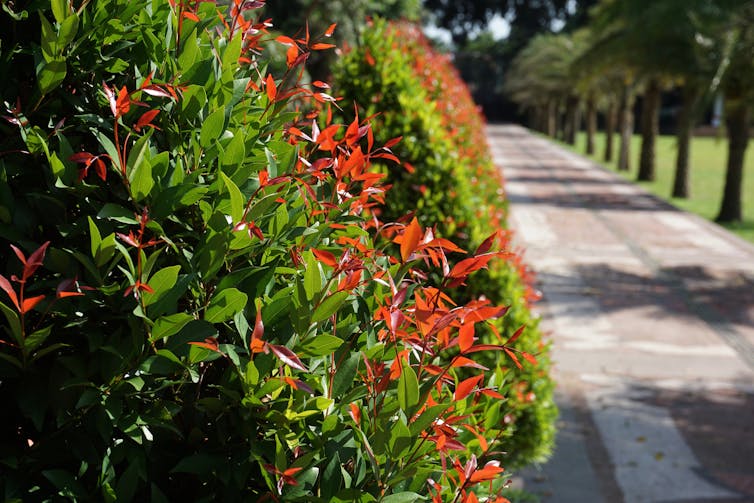
You’re probably familiar with the sight of a lillipilly bush. This hardy Australian staple – a glossy evergreen bearing powder-puff flowers and clusters of bright berries – features in many a garden hedge.
But you may not know this humble native has spread across the globe in waves of emigration, adaptation and evolution. Almost 1,200 species of lillipilly are now found in rainforests across the tropics and subtropics of Africa, Asia and the Pacific.
Our research helped reconstruct the evolutionary history of lillipillies in unprecedented detail. We show how lillipillies evolved in Australia and now form the largest genus of trees in the world.
Lillipillies are one of Australia’s great gifts to the natural world. But the story of these homegrown heroes may be taking a grim turn.

A plant on the move
Lillipillies began their international adventures about 17 million years ago. At that time, the Australian continent (which together with New Guinea is known as the Sahul Shelf) was colliding with Southeast Asia (known as the Sunda Shelf) following its breakup with Antarctica. This breakup was the final dramatic act of the fragmentation of Gondwana.
The collision provided opportunity for biotic exchange between the northern and southern hemispheres. Many plants and animals moved south to the Sahul Shelf and prospered in the new lands. Lillipillies are one of the few lineages that moved in the other direction.
Along with our songbirds, lillipillies stand as a rare example of an Australian group that set out from these shores and achieved major evolutionary success abroad.

Lillipillies light up our lives when they flower and fruit. Their showy white, cream or red flowers are followed by succulent red or purple berries. They’re a magnet for pollinators, helping fill our gardens with the songs of insects and birds.
The riberry, Syzygium luehmannii, is one of the most commonly grown and stunning garden species. It produces heavy crops of delicious fruit rich in antioxidants and prized by chefs.
Many species in the genus are used as food and medicine by Indigenous people, and potent antibacterials have been identified in the leaves of some species. Cloves, a favourite spice of home bakers, are the dried flower buds of an Indonesian lillipilly – the aptly named Syzygium aromaticum.
About 75 species of lillipilly are native to all Australian states and territories except South Australia and Tasmania.
The greatest concentration of species is in the Wet Tropics World Heritage Area of northeast Queensland. About 50 species are found there, half of which occur nowhere else on Earth.
And almost 1,200 species of lillipilly are now found in rainforests across the tropics and subtropics of Africa, Asia and the Pacific, including Australia.
As is common in the tropics, species new to science are regularly discovered and named. For example, almost 30 new species of lillipilly have been named from New Guinea in the last two years – and many more are likely awaiting scientific discovery.
But how did lillipillies achieve such international success? Our research team decided to find out.
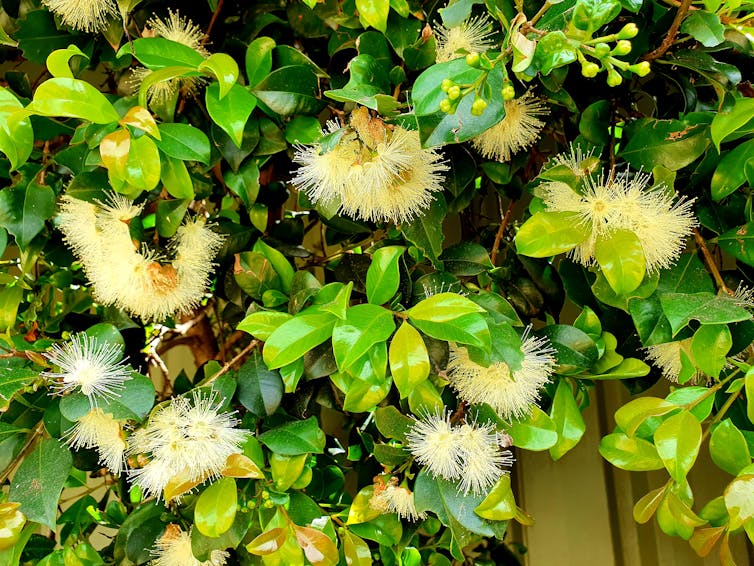
Peering into the past
The research, led by colleagues in Singapore, involved analysing the genomes of hundreds of living species of lillipillies.
Similarities and differences in the structure of genomes can reveal how closely related the species are. Using that knowledge, we can build up a picture of their genealogy - the “family tree” that connects ancestral species and their descendants.
These techniques also allow us to estimate the amount of genetic change that has occurred along the branches of the genealogy. And, if we’re lucky enough to have an accurately dated fossil of an ancestral species – as we do for lillipillies – we can calculate the rate of genetic change even more accurately.
All this allowed us to peer deeply into the past and reveal the events that set the lillipillies on their global journey.
We already knew lillipillies evolved in Australia and emigrated into the rainforests of Africa, Asia and the Pacific. Our research showed this dispersion occurred in at least a dozen distinct waves.
Each emigrant lineage diversified rapidly and successfully in its new environment. This resulted in the nearly 1,200 lillipilly species found worldwide today – more than any other tree genus. In contrast, their relatives the eucalypts have largely remained only a local success story.
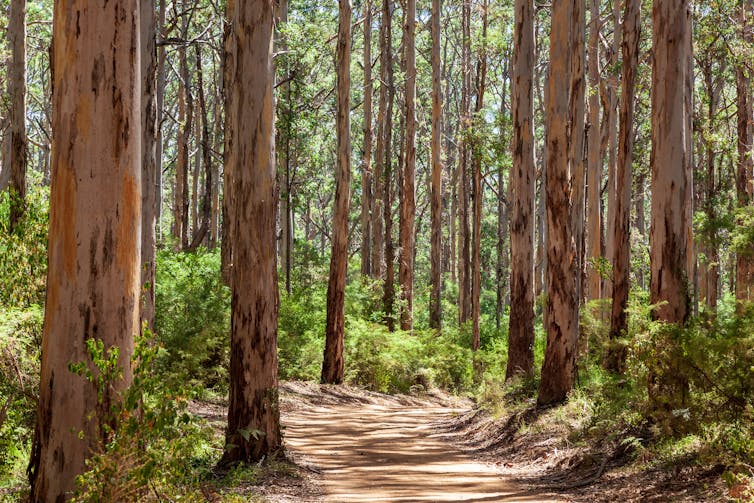
A sad twist?
Lillipillies may be one of Australia’s most successful botanical exports, but their future, like that of many rainforest plants globally, is threatened by habitat degradation and climate change.
The Magenta Cherry (Syzygium paniculatum), for example, is endangered by coastal development in New South Wales. And the Brotherly Love Lillipilly (Syzygium fratris), found only on Queensland’s highest mountain, is highly vulnerable to climate change.

But a devastating disease – myrtle rust - may be the most potent threat of all. It’s caused by an introduced fungal pathogen and kills new foliage, flowers and fruits of plants in the family Myrtaceae, to which lillipillies belong.
Myrtle rust arrived in Australia in 2010 and spread rapidly in the wind and via human activity. Already, it threatens some plant species with extinction. Lillipilly species have been damaged by this serious disease, though none are under immediate extinction threat yet.
Lillipillies are an Australian origin story. They’re a major contributor to rainforest biodiversity and important to Indigenous cultures. And they’ve endeared themselves to generations of gardeners and cooks.
Given all this, lillipillies deserve to be recognised – and protected – as Aussie icons.![]()
Darren Crayn, Professor and Director, Australian Tropical Herbarium, James Cook University
This article is republished from The Conversation under a Creative Commons license. Read the original article.
Want noisy miners to be less despotic? Think twice before filling your garden with nectar-rich flowers
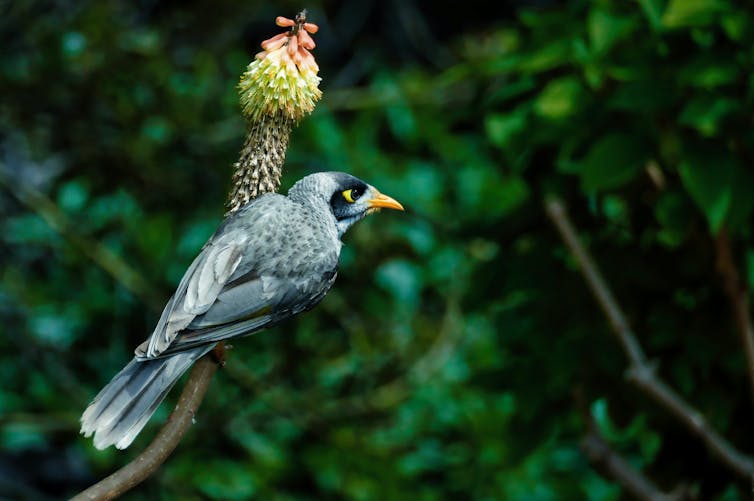
Noisy miners are complicated creatures. These Australian native honeyeaters live in large cooperative groups, use alarm calls to target specific predators, and sometimes help raise the young of other miners. But they’re perhaps best known for their aggressive and coordinated attacks on other birds – a behaviour known as “mobbing”.
We conducted a study investigating some of the possible factors that influence mobbing. We were interested in whether access to human food left on plates at cafes, or a high nectar supply thanks to planted gardens, might give urban miners extra energy and time to mob other species more often. We also examined whether miners were more aggressive towards some species over others.
Our study, published in the journal Emu - Austral Ornithology, found it wasn’t cafes with access to sugar-rich food that led to more miner aggression. In fact, gardens were where we recorded the highest amount of aggressive behaviour.
Understanding mobbing is important, because this behaviour can drive out other birds and reduce diversity. Smaller birds with a similar diet to noisy miners are particularly vulnerable.
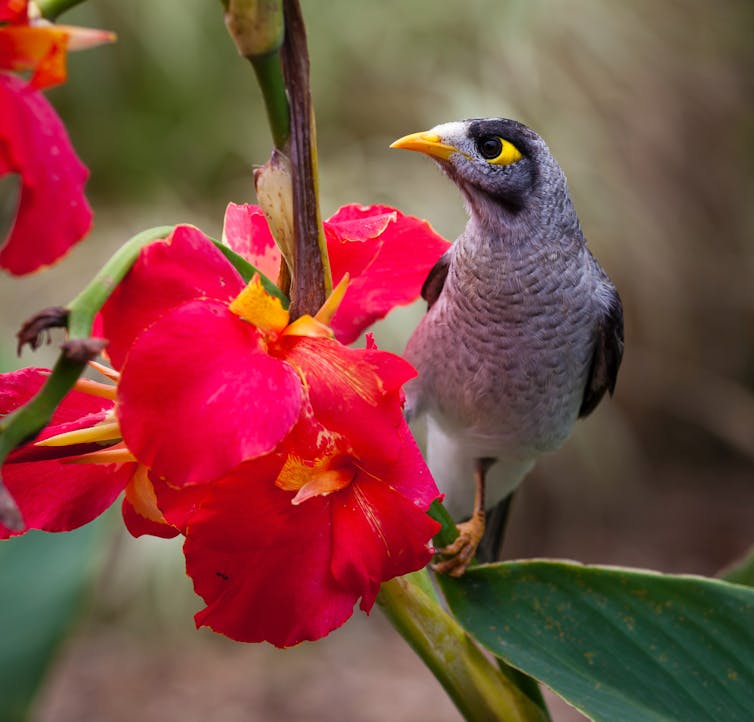
What we did
The noisy miner’s preferred habitat is along the edges of open eucalypt forest, including cleared land and urban fringes. Their numbers have grown in recent decades, presenting a significant conservation problem.
We know from previous research that urban noisy miners tend to be more aggressive compared with rural populations.
But to examine mobbing behaviour more closely, we placed museum taxidermies (stuffed animals) of different species of birds in three different types of habitat around Canberra:
urban cafes with lots of food leftovers
urban gardens that had higher-than-usual supplies of nectar
bush areas more typical of “natural” miner habitat.
For each habitat, we then presented the resident noisy miners with three different types of museum taxidermy models of birds:
food competitors with a similar diet to miners, both of the same size (musk lorikeets) and a much smaller species (spotted pardalote)
potential predators, including a dangerous species that preys on miners (brown goshawk) and a species that robs nests but poses less of a risk to adult miners (pied currawong)
neutral species, meaning a bird that does not prey upon nor compete with miners for food (in our study, we used a model of an eastern rosella).
We wanted to see how miners responded to these “intruders” in various settings. We also set up a speaker nearby to broadcast alarm calls, to see how miners reacted.

What we found
We found interesting differences in how miners responded to our taxidermy models and the broadcasted alarm calls.
Noisy miners exhibited aggressive behaviours for a much longer time in gardens and cafés in comparison to natural bush areas.
Surprisingly, however, access to sugar-rich food from cafes didn’t yield the most aggressive behaviour. Rather, we recorded the highest levels of aggressive behaviour near garden sites.
Nectar-rich plants (such as grevilleas and bottlebrushes) are attractive to birds with a sweet tooth, and miners are no exception. Newer cultivars flower for longer, meaning miners living in our gardens may have access to an almost year-round source of food.
Ready access to these flowering shrubs may affect aggression by providing more time, energy or reward to noisy miners defending these uber-rich resources.
The type of model presented also impacted miner response.
More miners were attracted to an area and mobbed the subject for longer when the model was of a predator.
Miners showed even greater aggression to food competitor models, however. They were more likely to physically strike food competitor models with a peck or swoop compared to predator models.
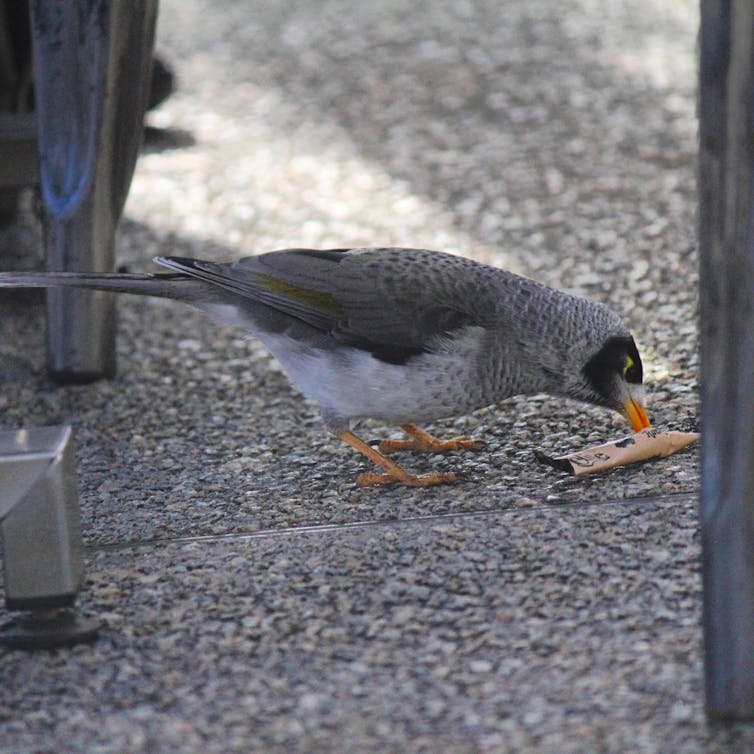
What can gardeners do with these findings?
Our research shows the importance of considering how gardens – whether in back yards, in parks or new housing estates – can affect local ecosystems, including bird behaviour. Previous studies have drawn a link between the types of plants humans choose to plant and the local mix of bird species.
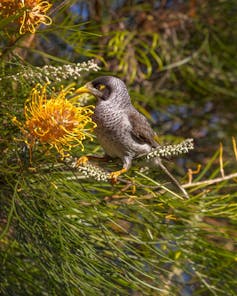
To reduce the risk of creating a perfect habitat for despotic miners in your garden, aim to:
plant multi-layered levels in your garden – that means including ground cover, small shrubs, medium shrubs and trees to provide shelter at different heights for various birds and animals
consider planting plenty of dense shrubs with small flowers to attract insects and provide shelter for small birds
use a mix of nectar-rich and non-flowering shrubs and grasses (instead of focusing too heavily on flowering plants)
try to avoid planting too many exotic species; opt instead for native plants local to your area and suited to the climate, as these benefit native plants and animals whilst minimising benefits to aggressive noisy miners.

Jade Fountain, PhD Student, University of Adelaide and Paul McDonald, Professor of Animal Behaviour, University of New England
This article is republished from The Conversation under a Creative Commons license. Read the original article.